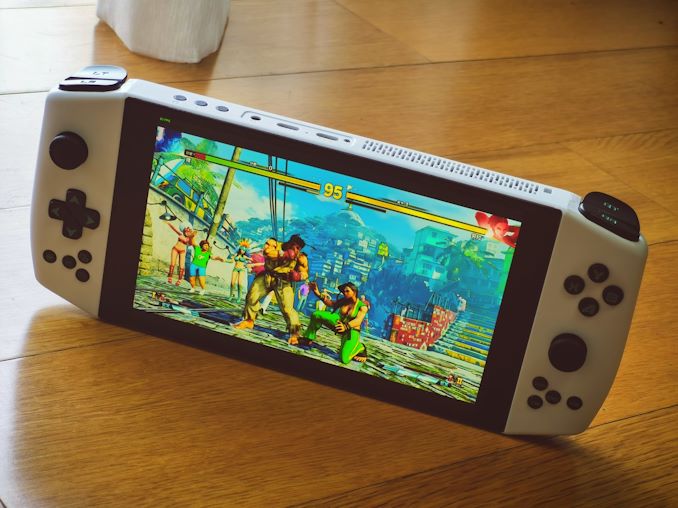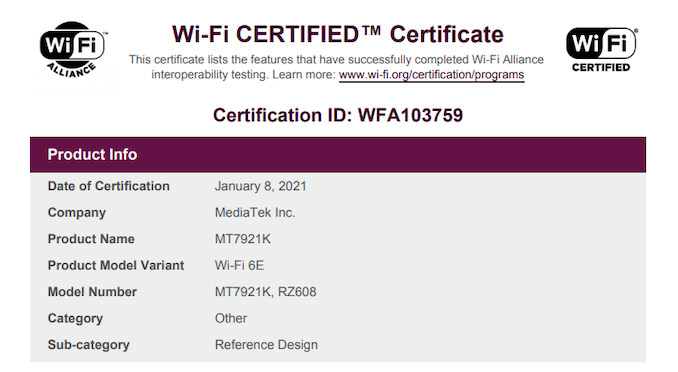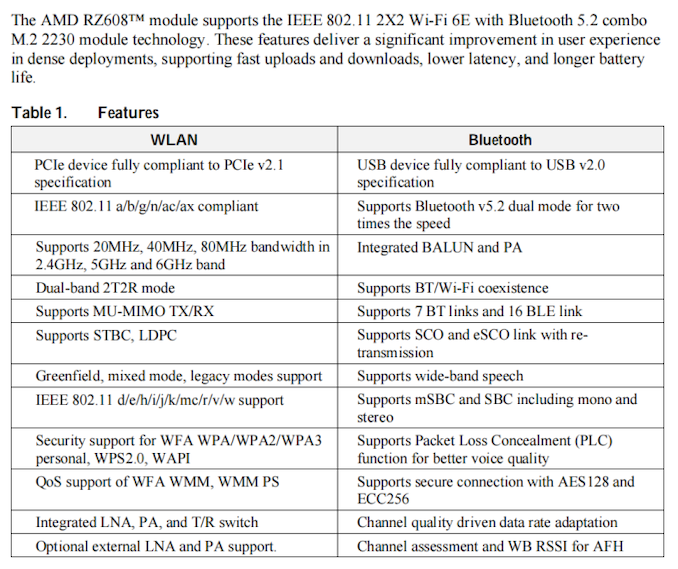AMD's Wi-Fi 6E Module: The RZ608
by Dr. Ian Cutress on May 10, 2021 5:34 AM EST
One of the elements of building a complete end-to-end solution means having all the components under one brand. The complexity of modern gadgets means that having everything made under one company is near-on impossible - especially with the wealth of IP and patents in every small segment of the modern electronic device. To facilitate the appearance of uniform branding, companies will often rebrand the components under their own name. Introducing the AMD RZ608, a Wi-Fi 6E 2x2 wireless module!
As discovered by Laczarus, the new handheld device called the AYANEO uses a wide array of AMD components, starting with the AMD Ryzen 5 4500U mobile processor which is a six-core Zen 2 chip with Vega 6 graphics. It also has a 7-inch display, and it runs a full version of Windows in a handheld device, something akin to an x86 competitor to the Nintendo Switch, albeit crowdfunded and currently shipping to initial backers.
On an update posted to the crowdfunding site on May 9th, the developers behind the project announced that their second batch of 2000 units will be using an unannounced AMD Wi-Fi 6E module. The post states that the AYANEO might very well be the first device with this module in production, and they leverage their cooperation with AMD for the integration with this part as well as troubleshooting. It is also noted that the AMD solution is slightly more expensive than the standard Wi-Fi 6 that was initially part of the design.
So here comes the crux: AMD doesn’t make the Wi-Fi module. Through our sleuthing, this is actually a rebranded MediaTek MT7921K module with an AMD logo on it. MediaTek sells the modules to AMD who brands them, but also leverages the regulatory compliance that MediaTek has already done for this product. AMD then takes over custom integration projects, sales, marketing, and support for the module. The RZ608 sold by AMD is in an M.2 2230 form factor and uses PCIe 2.1, although the AYANEO likely is using a more custom integration. There is also Bluetooth 5.2.
The use of the partnership with MediaTek will likely allow AMD to partner its mobile processors with its own branded Wi-Fi 6E solution with OEM partners when it comes to designing devices. Intel leverages the fact that it has Intel CPU, Intel Wi-Fi, Intel Thunderbolt, and Intel Ethernet as a combined sales opportunity for OEMs making devices around an Intel product, so it appears that AMD is leveraging the same ecosystem gains, albeit with rebranded components.
There was an unconfirmed rumor going around the internet last year about a collaboration between MediaTek and AMD co-creating some custom wireless designs, with some reports suggesting that the collaboration will go beyond Wi-Fi. We're not sure to what extent AMD has had any input in the design of the MT7921K / RZ608, or how much that will continue going forward. At this point I'm confident that this sits as a rebrand just for now, given the lifecycle of product development in this area, as well as the Wi-Fi certification being in MediaTek's name.

Wi-Fi Alliance Certification of MT7921K/RZ608












51 Comments
View All Comments
Matthias B V - Monday, May 10, 2021 - link
I know and you are correct - For now I do not think they separate big and small cores.However in the long it might offer the highest flexibility.
They now have to start from somewhere and live with silicon, fab and software limitations e.g. having two chiplets + I/O die for RDNA3. However in the long run I also would expect them to want smaller chiplets that they could combine in APUs or just build GPUs in different sizes adding between n to n+1 chiplets.
And once that is possible they might want similar approach for big and small cores. Maybe I am wrong and it will always be a chiplet with big and small cores as it makes sense but I kind of think at some point they want to separate them finding a better solution and better connecting / stacking tech.
Kevin G - Monday, May 10, 2021 - link
How many changes the OS would need to have is entirely dependent upon implementation. The big catch with this design is that it takes up a significant amount of silicon area to pull off as by design all of it can't be operable simultaneously. For mobile that's probably ideal as the larger core only wakes when needed. The smaller cores though wouldn't find much use while chained to the larger cores when dealing with well designed throughput oriented server software: the area invested in the smaller cores could have been used for more larger cores.nandnandnand - Monday, May 10, 2021 - link
@e36Jeff That sounds excellent if they do it and it works.nandnandnand - Monday, May 10, 2021 - link
It sounds like you want Rembrandt, which was just rumored to have up to 12 CU RDNA2. Maybe that would get cut down to 10-11 CUs on a 6-core CPU model.According to an older leak, it will support two USB4 ports: https://www.notebookcheck.net/New-leak-AMD-Ryzen-6...
scineram - Monday, May 10, 2021 - link
i think they would have been better off with Van Gogh than Renoir.nandnandnand - Monday, May 10, 2021 - link
It has to exist first. If it does come out, it would probably have higher FPS from RDNA2 and faster RAM, and better battery life. Perfect for a handheld. Maybe quad-core Rembrandt with TDP-down can achieve the same thing.Spunjji - Monday, May 10, 2021 - link
I'll be sad if Van Gogh never sees the light of day, but you're right, it's possible Rembrandt (if it exists) would fill a similar niche.Smell This - Tuesday, May 11, 2021 - link
I thought Van Gogh was <10w Zen2 Renoir (with maybe RDNA + LPDDR4x memory support?)
nandnandnand - Tuesday, May 11, 2021 - link
AYANEO = Ryzen 5 4500U, 6 Zen2 cores, 6 Vega CUs, 10-25 Watt TDPvs. Van Gogh, 4 Zen2 cores, possibly 8 RDNA2 CUs, lower TDP range, support for faster, more efficient RAM (i.e. LPDDR5)
Most current games won't miss the 2 CPU cores, and graphics performance would be way up. With more battery life for a handheld.
Rembrandt mobile is rumored to have up to 8 Zen3+? cores and 12 RDNA2 CUs. A quad-core Ryzen 3 5400U successor could end up with 8-10 RDNA2 CUs.
Prosthetic Head - Monday, May 10, 2021 - link
Linux support?If so, as an open source module in the vanilla kernel, open but manual, or a binary blob?